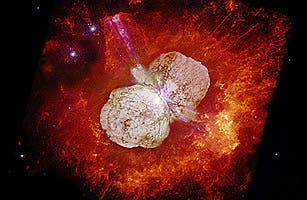
Around 1843, on the night sky all of a sudden a new luminous star made its appearance. That luminous star, which at the time was actually the 2nd brightest star, after Sirius, was actually the result of a explosion in Eta Carinae system – the brightest star in the Milky Way. The eruption spewed a mass 10 times that of our sun into space, and shined with intense brightness for 20 years or so, then faded and left behind a majestic, billowing cloud of gas known as the Homunculus Nebula. This event was called by astronomers a “supernova impostor”, as the star didn’t die, it just had a local, albeit extreme, explosion. Now, scientists are studying this event that took place almost 170 years ago in real-time (yes, as if it were happening right now), by analyzing the light echoes it left behind. This gets interesting.
Observing Eta Carinae’s detailed structure has proven to be extremely difficult for astronomers, because of the Homunculus Nebula in which the system is engulfed – a thick cloud of dust and gas which was highly disturbing. The 1843 flare-up played out over 20 years, and XIX century astronomers did their best to observe and study it, however lacking the modern technology of today, they could only do so little. If only this bright explosion took place during our time…
Few events remain unrecorded in the Universe’s history however, and considering scientists have been able to trace back some of the events close the very dawn of existence, capturing information that was transmitted just barely two centuries ago shouldn’t have posed too much of a headache for the researchers.
When Eta Carinae erupted, light was blasted in all directions. Some reached Earth in the XIXth century, while other traveled for years and years through space, some eventually reaching cloud nebulae, which at turn reflected the light back to Earth with a delay. This light contains all the information scientists need, it’s basically like they would watch a faithfully accurate recording. Moreover, astronomers can study light echoes from a variety of different dust clouds, at varying distances from the star. That creates detours of varying lengths, so they can see different phases of the eruption all at once.
“The big puzzle,” says Jose Prieto, a co-author of the report. “is what caused the outburst. This star has been studied to death with all sorts of telescopes, but no one theory has ever been able to tell us what happened.”
The researchers admit that they currently do not know what caused the explosion, although there’s a somewhat mutually agreed assumption that the eruption took place from inside the star, which is 100 times the mass of the our own sun. They still have around 19 years and a half worth of real-time information coming through, so as the researchers go through all the phases of luminous blue variable explosion, they might be able to decipher what went on. Eta Carinae is somewhat at the end of its existence however, as astronomers believe it should blow in a supernova event very soon.
“We know it’s close to the end of its life,” says astronomer Armin Rest, of the Space Telescope Science Institute and the lead author of the paper. “It could explode in a thousand years, or it could happen tomorrow.”
At 7,500 light years from Earth, though, such an event would pose absolutely no threat to life on Earth, even if it were of an even massive dimension. When it’s finally going to die, though, Eta Carinae will most surely go down with a bang, most likely resulting in one of the most brightest spots in sky, if not the brightest – one to last for centuries.
The findings were published in a recent edition of the journal Nature.






